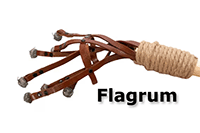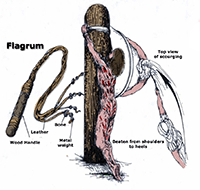Crucifixion and Flagellation (Scourging)
A part of the execution process that became a routine preliminary to crucifixion was a flagellation known as "scourging." (Such flogging was a legal preliminary to every Roman execution, and only women and Roman senators or soldiers were exempt.)  The Roman whip used to accomplish the beating was called a "flagrum," or "flagellum." This had a short wooden and leather-wrapped handle to which were fixed three of more leather straps. These straps were knotted with small pieces of metal or bone attached at various intervals. At times, a flagrum would also have a hook at the end of one strap that was called the "scorpion." With or without the "scorpion," the flagrum would quickly remove skin from the victim and create deep lacerations with exposed ribbons of muscle.
The Roman whip used to accomplish the beating was called a "flagrum," or "flagellum." This had a short wooden and leather-wrapped handle to which were fixed three of more leather straps. These straps were knotted with small pieces of metal or bone attached at various intervals. At times, a flagrum would also have a hook at the end of one strap that was called the "scorpion." With or without the "scorpion," the flagrum would quickly remove skin from the victim and create deep lacerations with exposed ribbons of muscle.

The victim to be scourged was stripped and made to stretch his arms around a pillar, boulder or another large object. His hands were then bound tightly on the other side of the pillar or boulder so that his back stretched taut. The back, buttocks, and legs were flogged either by two soldiers (lictors) or by one who alternated positions. The severity of the scourging depended on the disposition of the lictors and was intended to weaken the victim to a state just short of collapse or death. As the Roman soldiers repeatedly struck the victim’s back with full force, the attached iron balls would cause deep contusions, and the bones would cut into the skin and subcutaneous tissues. As the flogging continued, the lacerations would develop in the underlying skeletal muscles and produce quivering ribbons of bleeding flesh and would sometimes even expose the internal organs. The extent of blood loss may well have determined how long the victim would survive on the cross.
The two soldiers would alternate hits, beating the victim continuously. According to Jewish law, you could not beat someone more than 40 times, so the Jews always stopped at 39 lest they miscount and accidentally sin against God. The Romans, however, had no such law. The church historian Eusebius of Caesarea recounted (in Ecclesiastical History, Book 4, chapter 15) a scene of scourging...
The purpose of this torture was to prolong suffering. However, historians wrote that sometimes those who were given this punishment did die. Roman soldiers were trained to begin with the upper torso. They would beat down the back, down the chest, up the back of the legs and up the arms. The weighted ends of the flagrum would strike with a concussive force that could bruise internal organs, and against the chest, could cause a contusion of the heart. Ribs were routinely broken leading to painful, restricted bleeding. Blood loss during a scourging was severe with victims sometimes losing consciousness. At times scourge victims suffered blows to both the face and the top of the skull. Josephus noted that certain rebellious Jews were torn to pieces by the scourge before being crucified. Accurate Movie Representation (Viewer discretion advised)
Isaiah 50:6 Isaiah 52:14 Mark 15:15
Artist Renderings

The actual depredation of Jesus was too gruesome and intense for artists to portray in their renderings of the flagellation of Christ. While many portrayals of his beating were created over the years, art viewers were spared the truth about what he must have endured.
Examples of such renderings can be seen by clicking the image to the left.
Click Image
